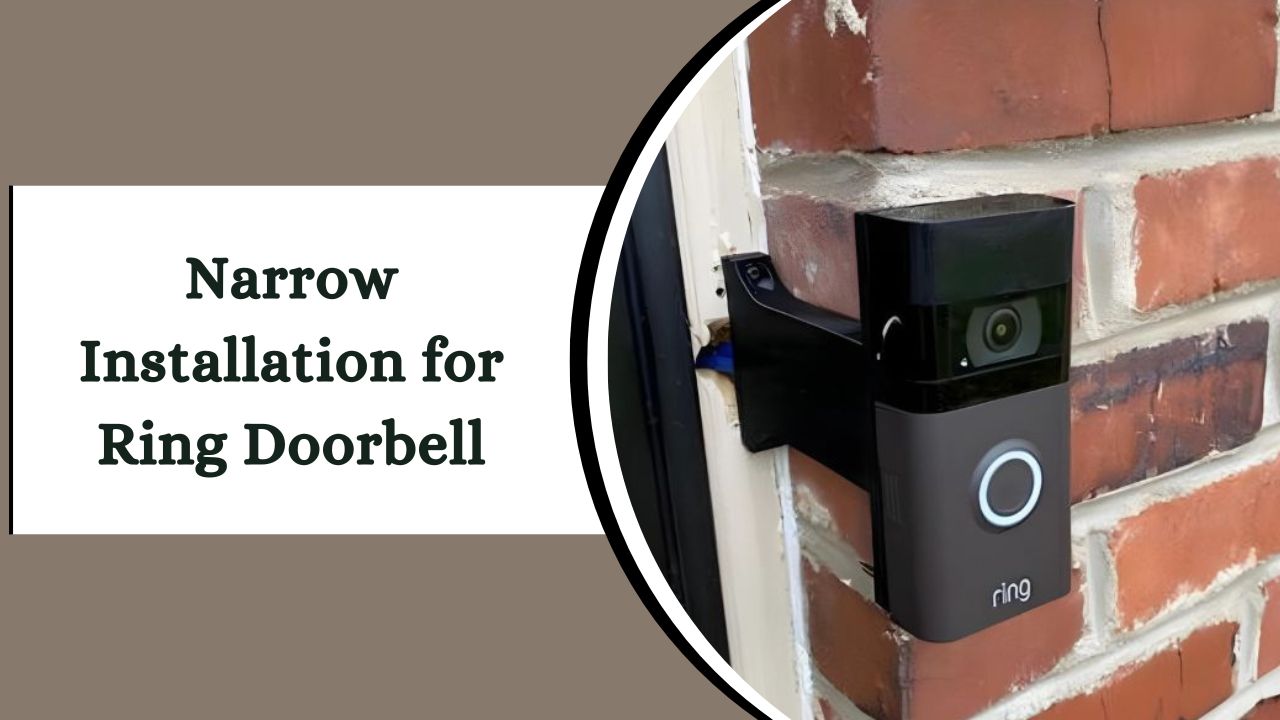Installing Ring doorbells in narrow spaces can be challenging due to their wide-angle lens design. This guide offers practical solutions to ensure your Ring doorbell works effectively in tight or unconventional spaces, addressing issues like inset doors and thin door frames.
How To Install Ring Doorbell In Narrow Space?
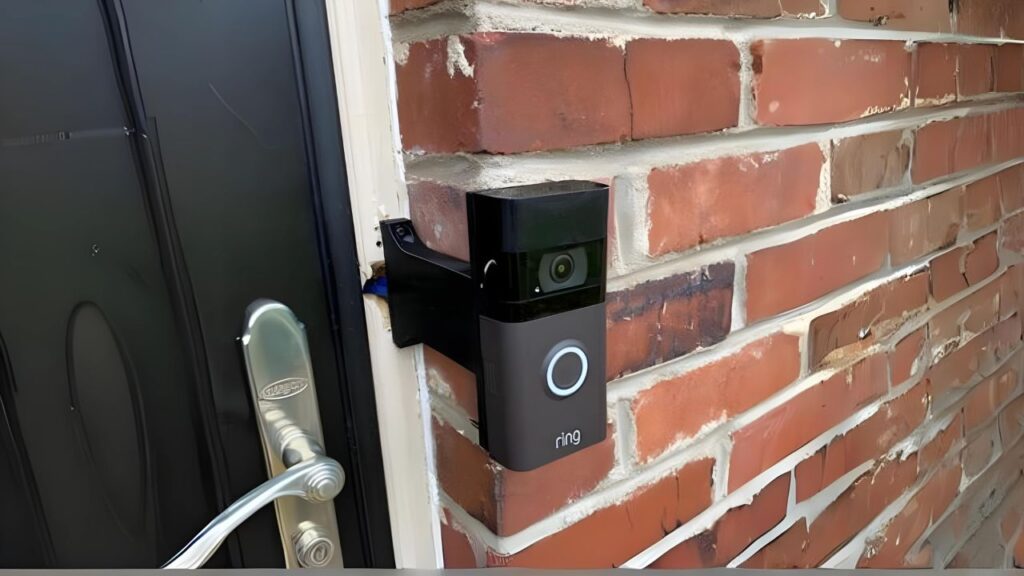
To install a Ring Doorbell in a narrow space, follow these steps:
- Select the Appropriate Model and Assess Installation Space: Measure your door frame’s width and choose a slim Ring model, such as the Ring Doorbell Pro. Ensure it fits the available space.
- Utilize Angling Accessories: If the doorbell can’t face forward due to space constraints, use corner or wedge kits to adjust its angle for optimal video capture.
- Explore Alternative Mounting Options: For extremely narrow spaces, consider mounting the Ring Doorbell on an adjacent wall or use the Ring Peephole Cam, especially suitable for renters or those unable to drill holes.
- Secure Installation Without Drilling: If drilling is not an option, mount the Ring Doorbell using non-intrusive methods like velcro straps or double-sided tape, particularly for indoor setups like the Peephole Cam.
- Optimize the Camera’s Field of View: Position the camera to minimize blind spots and maximize coverage of the entrance area, adjusting the angle to capture a comprehensive view of visitors.
- Test and Maintain the Setup: After installation, test the doorbell’s functionality, including its motion detection and video quality. Regularly update the software and check the device to ensure it continues to operate effectively in its new position.
Why Installing Ring Doorbells in Narrow Spaces is Challenging?
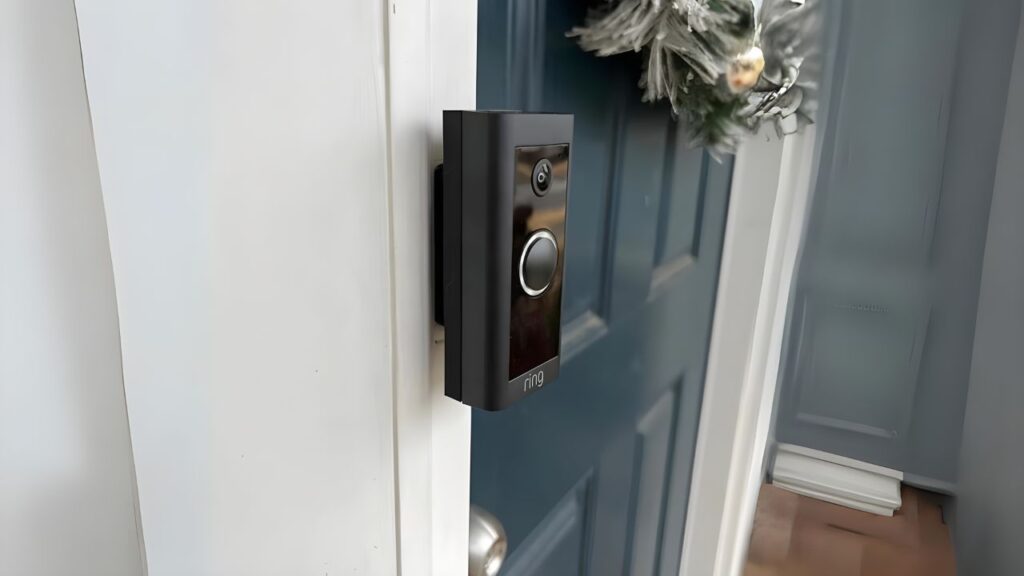
Installing Ring doorbells in narrow spaces presents unique challenges due to their design. These doorbells are intended to capture a wide view of the outside, which is one of their main selling points.
However, the wide-angle lens can struggle in confined spaces, potentially limiting the doorbell’s ability to provide a comprehensive view. This limitation can impact the doorbell’s effectiveness, as offering a full view is crucial for home security.
However, This Approach Comes With Several Problems
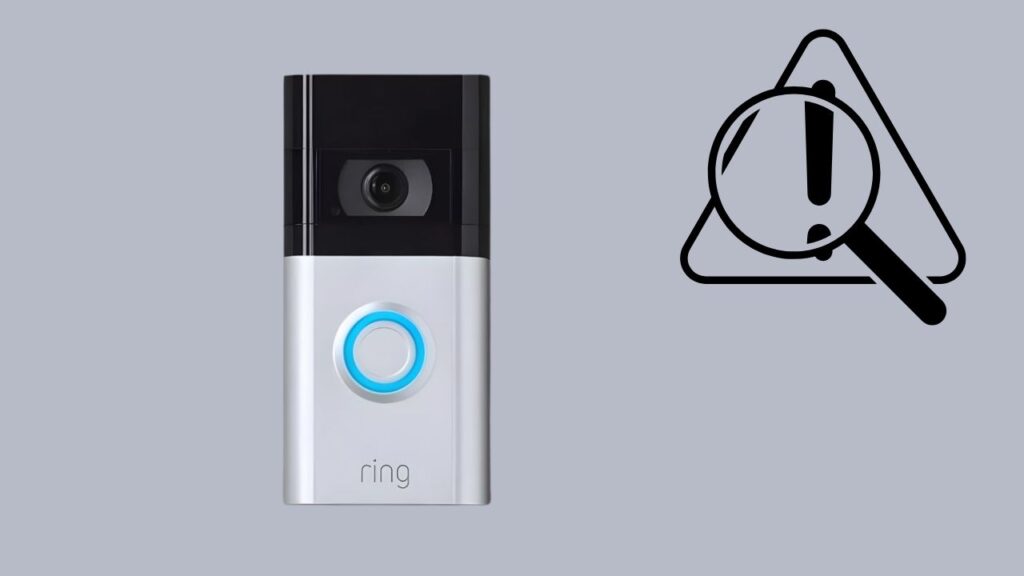
1. Inset Doors:
When the door frame is recessed into the wall, the camera may capture more of the wall than visitors, creating blind spots. This can be particularly problematic for crime prevention, as intruders could approach undetected.
An inset door configuration without a porch may result in incomplete footage, missing crucial facial identification and compromising the ability to effectively monitor visitors and deter crime.
2. Thin Door Frames:
The Ring Doorbell 2, with a width of 2.5 inches, can be too wide for narrow door frames. The slightly slimmer Ring Doorbell 1, at 2.4 inches wide, still faces challenges, especially with its internal battery that requires hardwiring, making it bulkier.
Similarly, the Ring House Phone 2, despite its smaller standard size, has a built-in battery that adds to its bulk, complicating installation in thin or narrow frames.
Solutions for Installing Ring Doorbells in Narrow, Inset, or Corner Spaces
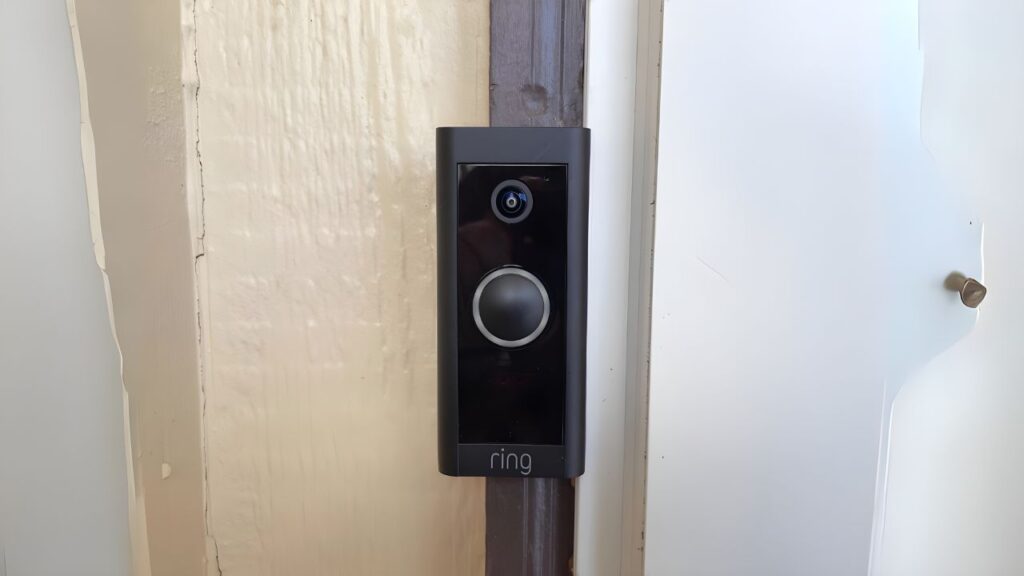
Adapting Ring doorbells to fit narrow, inset or corner spaces can be challenging. Here are some effective solutions to ensure optimal functionality despite spatial limitations:
1. Use a Corner Kit:
For narrow or corner installations, a corner kit can be invaluable. It adjusts the doorbell’s direction, improving its field of view and video capture.
This is especially useful when a wall obstructs part of the view or in confined areas, reducing blind spots caused by side walls. The corner kit typically offers a tilt range of 30-50 degrees, enhancing visibility and overall property security.
2. Use a Wedge Kit:
If standard mounting heights aren’t feasible, a wedge kit provides a practical solution. Wedge kits allow for vertical tilting, adjusting the viewing angle to accommodate unique positions, whether high or low.
This method is essential for installations where obstructions might impede recording, ensuring a clear view of approaching guests, roads, and neighbouring homes. The kit includes three stackable wedges for flexible adjustments.
3. Choose Ring Doorbell Pro 1/2 or Wired Models:
For narrow, inset, or corner spaces, opt for Ring’s hardwired Pro 1, Pro 2, or Wired versions. These models are sleeker than battery-powered options and better suited for restricted spaces.
For instance, the Ring Doorbell 2, a battery model, is bulkier compared to the more compact Pro models, making the latter ideal for narrow installations. Visiting an electronics store to compare the battery and Pro models can be helpful.
4. Mount on Your Main Wall:
If the door frame is too narrow, consider mounting the Ring doorbell on the main wall instead. This approach is suitable for Ring Doorbells 1 and 2, which do not require hardwiring.
Wall mounting offers flexibility in space and video capture, ensuring proper visitor capture without obstruction. This method is practical for those facing challenges with hardwiring or needing to run cables through walls, and it increases visibility for visitors.
5. Mount on Your Door:
For narrow installations, mounting the Ring doorbell directly on the door is an effective solution, especially for battery-powered models (1, 2, 3, and 4). This method eliminates the need for hardwiring and avoids cable snagging when the door opens or closes.
Rechargeable batteries ensure there is no risk of dangerous cable slack, and this placement allows for better video captures, ensuring visitors are centrally positioned in the footage.
6. Use a Peephole Cam:
If drilling into the exterior or using other solutions isn’t feasible, the Ring Peephole Cam offers an innovative alternative. It replaces your door’s peephole with a smart camera, providing benefits like two-way communication and HD video.
Mounted inside your property, it eliminates the need for external alterations, making it ideal for renters or those unwilling to make permanent changes. Installation with velcro straps or double-sided sticky tape ensures minimal intrusion, and its indoor placement enhances security by making it more difficult to steal.
These solutions help ensure your Ring doorbell functions optimally, even in challenging installation scenarios.
Next Steps After Installing Your Ring Doorbell in a Narrow Space
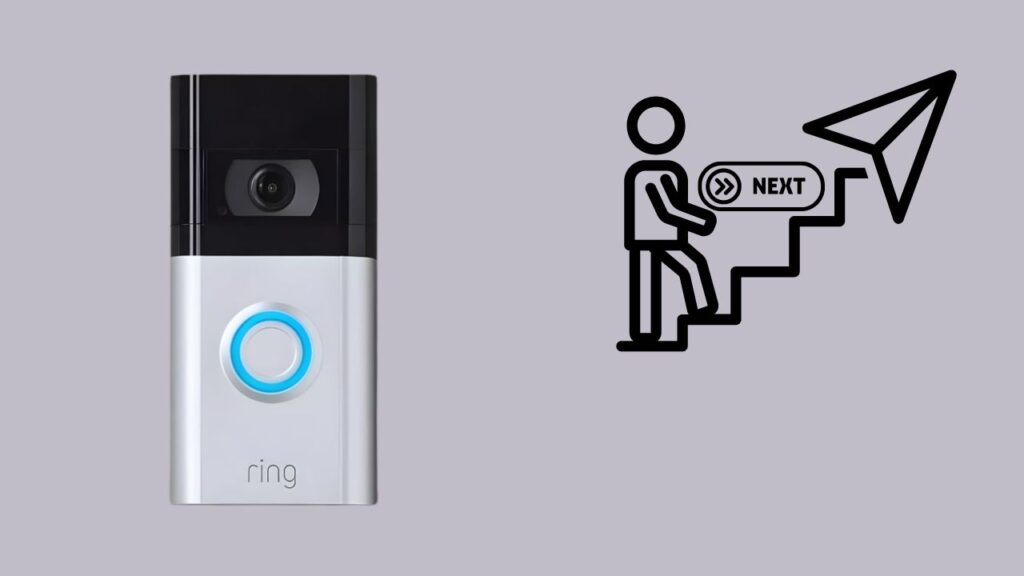
After successfully installing your Ring Doorbell in a narrow space, the next steps involve fine-tuning and optimizing its performance.
Start by adjusting the camera angle to ensure it captures the desired area, keeping in mind the limited installation space. Next, customize your motion detection settings to avoid false alerts, which can be common in narrow setups.
Finally, test the video quality and audio clarity by conducting a few test calls with family members or friends. This hands-on testing helps you identify any issues early, ensuring your doorbell functions smoothly.
More Things People Look For:
What is the Minimum Distance for a Ring Doorbell?
When installing a Ring doorbell, understanding the range of its motion sensors is crucial. These sensors effectively detect motion within a 180-degree horizontal field, with an optimal range of five to 30 feet from the fixture.
This minimum distance is essential for ensuring that your Ring doorbell captures relevant movements and activities, providing the security and convenience it’s designed for.
Can You Install a Ring Doorbell on a Door Frame?
Yes, you can install your Ring doorbell on a door frame, and the process is straightforward. The ideal height for installation is about 48 inches from the ground.
Ensure the device is level by using the provided level tool, which helps position the doorbell for optimal functionality and aesthetics.
What Happens if the Ring Doorbell is Too Low?
Installing your Ring doorbell at the recommended height of 48 inches is important for effective motion detection. If installed lower, the doorbell might miss detecting crucial activities, particularly if there are stairs leading to your porch or if it faces a busy street.
Incorrect height can affect the motion capture angle, reducing the doorbell’s surveillance effectiveness and potentially missing critical moments.
Is it Safe to Install a Ring Doorbell on a Narrow Frame?
Yes, installing a Ring doorbell on a narrow frame is safe if proper installation practices are followed. Use the included spacers to prevent damage to the door or the device and ensure the power source, such as the battery, is unobstructed. Following these guidelines makes installing your Ring doorbell on a narrow frame both feasible and safe.
Which Ring Doorbell Models Suit Narrow Installations?
While all Ring Doorbell models can be installed on narrow surfaces with the right accessories, smaller models like the Ring Video Doorbell Wired or the Ring Video Doorbell Pro are more compact and may be easier to fit on narrow frames.
Is Professional Installation Available for a Ring Doorbell on a Narrow Surface?
Yes, you can hire a professional installer to ensure your Ring Doorbell is securely and properly installed on a narrow surface. They can assess your specific situation and use the best installation method for your home.
Our Final Take
Installing a Ring doorbell in narrow spaces can be challenging. By choosing the right model, using angling accessories, and exploring alternative mounting options, you can ensure effective functionality and security.
Proper installation and maintenance are crucial for optimal performance.

